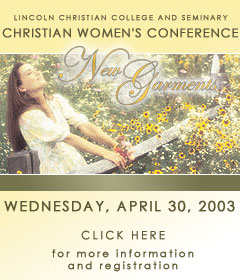|
Features,
Honors
& Awards, Ag
Announcements
Calendar,
Ag News Elsewhere
(fresh daily from the Web)
|
|
Features
|
|
Weekly outlook
Soybean prices
[APRIL
29, 2003]
URBANA -- It is likely that
the trading range of November 2003 soybean futures will be expanded
and that the expansion will come from a new life-of-contract high,
said a University of Illinois Extension marketing specialist.
|
|
"It is not clear when over the next six
months a new high would come or what factors would contribute to
higher prices, although U.S. crop concerns would be one candidate,"
said Darrel Good.
Good's comments came as he reviewed
recent activity in the soybean market. The average spot cash price
of soybeans in central Illinois reached a 2002 post-harvest low of
$5.01 on Oct. 9, 2002. That price reached a high of $6.145 on April
17, 2003, and then declined by nearly 20 cents by April 25.
"The higher prices since mid-January
have been driven primarily by the fast pace of U.S. exports and
export sales, particularly to China," said Good. "As of April 24,
cumulative shipments of U.S. soybeans for the current marketing year
totaled 909.5 million bushels, according to the USDA's report on
export inspections. Cumulative exports were 3 percent larger than at
the same time last year.
"Unshipped sales as of April 17 stood
at 98 million bushels, 2.5 percent more than outstanding sales of a
year ago. Shipments to China through April 17 totaled 269 million
bushels, 74 percent larger than cumulative shipments of a year ago.
China accounted for 30 percent of U.S. soybean exports and eclipsed
the European Union as the largest buyer of U.S. soybeans."
Cumulative shipments plus outstanding
sales of U.S. soybeans as of April 17 totaled 999 million bushels.
For the year, the USDA officially projects exports at 995 million
bushels.

"However, accounting for the
discrepancy between USDA and Census Bureau estimates of exports to
date, the USDA has included an extra 10 million bushels in the
projection of residual use of soybeans this year," said Good. "In
effect, the USDA has projected exports at 1.005 billion bushels.
That is still 58 million less than exports during the 2001-02
marketing year."
The post-harvest trading range in the
cash price of soybeans in central Illinois has been $1.135. That is
within the experience of the past 30 years, although at the low end
of the range that has varied from 61Ĺ cents in 1985-86 to $5.20Ĺ in
1976-77.
"The recent price increase has
accomplished the mission of establishing a trading range within the
historical experience," said Good. "It is still unclear, however, if
cash soybean prices have established a post-harvest marketing year
high. In the short run, the answer to that question may be
determined primarily by the pace of exports and export sales.
[to top of second column in
this article]
|

"Sales and shipments are declining
seasonally, but with 18 weeks left in the marketing year, the pace
will have to decline sharply if the USDA projection is not to be
exceeded. Typically, cumulative export sales at the end of the
marketing year are 3 to 5 percent larger than shipments for the
year, with the excess being rolled into the new crop year. In
addition, in some years, cancellation of sales show up late in the
marketing year. As a result, the rate of export sales over the next
few weeks is important, but the rate of shipments may be a better
indicator of export demand."
Using a projection of 1.005 billion
bushels of exports for the year, shipments need to average only 4.64
million bushels per week for the remainder of the year to reach the
projected level. During the last 18 weeks of the 2001-02 marketing
year, shipments averaged 10.65 million bushels per week. Shipments
over the past five weeks have ranged from 11.1 to 13.3 million
bushels per week. A continuation of a high rate of exports would
suggest prices need to move higher to slow the rate of consumption.
"If the pace slows sharply in the next
few weeks, further price rationing may not be required," said Good.
"Longer-term, soybean prices will be influenced by the prospects for
the 2003 U.S. soybean crop. Producers have revealed plans to reduce
U.S. soybean acreage in 2003, and the fairly rapid pace of corn
planting may lead some to believe that soybean acreage will be below
March intentions. Average yield, however, will be the key to crop
size, and it is too early to project a yield very different from
trend value."
While old crop prices have satisfied
the historical trading range test, November 2003 futures have not.
That contract has a life-of-contract low of $4.53 and a high of
$5.43. The high was established in September 2002, but the contract
traded to $5.40 on April 22.
"Two observations can be made about the
price range," said Good. "First, the range to date of 90 cents is
very small. The smallest range in 'modern' price history was 91ľ
cents for the 1986 contract. The range for the 1999 through 2002
contracts -- a period of generally low prices -- varied from $1.62Ĺ
to $2.74ĺ.
"Second, the
high to date of $5.43 is very low. While the high price for the
November contract has been trending lower over the past seven years
-- from $8.25 for the 1996 contract to $5.91 for the 2002 contract
-- a new high for the 2003 contract would not be a surprise. The
life-of-contract low of $4.53 is within the experience of recent
history --$5.85 for the 1996 contract to $4.05 for the 1999
contract."

[University
of Illinois news release]
|
|
 |
|
|
Crops update
[APRIL
28, 2003]
Currently Logan County has
about 80 percent of the corn planted and about 3 percent of the
soybeans. As is always the case, producers canít just plant it and
forget it. Scouting for early season pest problems and stand counts
is something that just has to be done.
|
|
Black cutworms are one of the most
feared early season insects. Usually the cutworms donít affect a
large percentage of acreage, but they can be devastating on the ones
they do affect. Remember that black cutworms donít overwinter here.
They are blown into our area as moths that lay eggs.
Based on moth captures in certain
locations, it looks like the projected date of first cutting should
occur after May 15 in the Logan County area. Cut plants are
basically counted as stand loss in replant decisions. Treatment is
usually warranted when at least 3 percent of the plants have been
cut and you can find the cutworms present. Rescue treatments are
available for black cutworms and usually work well. Recommended
rescue treatments are one of the labeled pyrethroids or Lorsban
liquid.
Sometimes cutworms will just clip
leaves off corn plants. This may be due to the size of the larvae,
the species of cutworms and the size of the corn. The first sign of
cutworms being present is pinhole feeding on leaves.

Earthworm
populations
A study that has just been completed by
Eileen Kladivko from Purdue University deals with earthworm
populations in different tillage systems. Why the interest in
earthworm populations? Earthworms are normally considered an
important part of a highly productive soil. They also improve both
soil structure and tilth. Their tunnels provide for channels that
can improve water and airflow movement. And the manure of earthworms
increases fertility.


[to top of second column in
this article]
|

The study dealt with different
earthworm densities in silty clay loam fields near Purdue that had
been under different tillage practices for at least 10 years.
Continuous corn that was plowed had a density of 10 earthworms per
square meter, continuous no-till corn had 20, continuous soybeans in
a plow system had 60, continuous no-till soybeans had 140, bluegrass
and clover sod had 400, dairy pasture with manure had 340, and dairy
pasture with heavy manure had 1,300.
Comments were also made about the
effects of pesticides on earthworm populations: "Most herbicides
used in the Midwest are harmless or only slightly toxic to
earthworms." "Some corn rootworm insecticides are toxic to worms,
but narrower bands reduce their effects. In general, the
organophosphate and pyrethroid insecticides are harmless to
moderately toxic, while carbamates are highly toxic."
Field crop
scouting workshop series
The Logan County crop scouting series
has been scheduled to begin on May 21 at the Blair Hoerbert Farm at
2506 100th Ave., San Jose. The workshop will be from 9 to 11 a.m.
Approximately half the time will be devoted to classroom activities
and the other half to hands-on scouting.
Other sessions are scheduled for June
11, June 25, July 9, July 23 and Aug. 6 at other locations.
To get your
name on the list or get the complete schedule,
send us your name, address,
phone and e-mail address. (Logan County Extension, 980 N. Postville
Drive, Lincoln, IL 62656; e-mail
fultonj@uiuc.edu.)
CCA credits have been applied
for at each session.

[John
Fulton]
|
|
 |
|
|
Rep. Hartke appointed as
state agriculture
director
Effingham County farmer and legislator to take post April 28
[APRIL
26, 2003]
SPRINGFIELD -- Gov. Rod
Blagojevich has announced the appointment of longtime state
Rep. Charles "Chuck" A. Hartke as director of the
Illinois Department of
Agriculture.
|
|
Though the position requires
confirmation by the state Senate, Hartke will begin serving as
acting director on Monday, April 28.
"Chuck Hartke has been a farmer for
most of his life and -- even more important -- for the last 18 years
he's been an advocate in state government for people whose
livelihood depends on agriculture," said Blagojevich. "At this time
of unprecedented budget pressure, Chuck's experience will be
critical to my administration as we look for new ways to improve and
promote Illinois' vast agriculture industry."

Hartke, 58, has served in the Illinois
House since 1985 and has held a seat on the House Agriculture
Committee just as long. Much of his legislative work has focused on
helping Illinois' agriculture community. He sponsored legislation to
improve standards for "mega hog farms," to invest in value-added
products, to promote ethanol use, and to provide technical and
financial assistance to independent farmers. He also is a member of
both the Illinois Farm Bureau and the Farmers Union.
[to top of second column in
this article]

|
Hartke grew up on a farm in Teutopolis
in southern Illinois. After a tour of duty with the U.S. Army in
Vietnam, he and his wife, Kathy, bought a farm a mile from the one
on which he was raised. His son, Chris, now manages the 800-acre
operation. Before his election to the Illinois House, Hartke was
involved in Effingham County government and served on the county
board from 1971 to 1974.

"Chuck Hartke knows the challenges our
farmers face," Blagojevich said. "He'll do an outstanding job of
making sure the state's agriculture policies and programs do what
they are intended to do."
Hartke will
earn $113,200 in his new post.
[Illinois
Government News Network
press release]

|
|
 |
|
|
Innovative multi-technology course
on plant diseases offered off campus
[APRIL
25, 2003]
URBANA -- For more than 20
years, plant pathologist Wayne Pedersen has taught several courses
in the off-campus graduate program at the University of Illinois.
This involved extensive traveling and time away from campus.
|
|
Last fall, Pedersen decided a change
was in order. He developed "Diseases of Field Crops" into the first
online graduate course in the Department of Crop Sciences.
"Since a great deal of the class
involves the use of high-quality color slides, putting the entire
course on the Web would not have worked for students with telephone
connections; the transfer rate would be just too slow," Pedersen
said. "Instead, I developed a CD that contains all of the lectures
as well as class notes, old exams and quizzes, and additional
references."
He prepared PowerPoint presentations
for each disease or group of diseases and then added audio for each
slide used in the class.
"Individual presentations are from 15
to 25 minutes long," Pedersen said. "That way a student can listen
to the audio, take notes or replay the audio before going on to the
next slide. At the end of every presentation, students are provided
with several websites that provide additional information."
He notes that the students could listen
to the lectures any time, rather than being tied down to a regular
class schedule.
"Last fall nine students signed up for
the course," he said. "Students were responsible for three to four
lectures each week, and then a threaded discussion was held for
three hours each Thursday night."
Pedersen used a product called WebBoard
for the threaded discussion sessions. The format is similar to
having several chat rooms, but a permanent record is kept until the
end of the semester.
On a given evening, Pedersen can open
three or four chat rooms or conferences, each on a different disease
topic, and then post several questions to which students could
respond.
"Some of the discussions were very
lively, especially with the control of soybean cyst nematode, sudden
death syndrome, or seedling blights on corn or soybeans," Pedersen
said. "If a student had to miss a class, they could go back to the
website and review all of the discussion on each disease. However,
very few students ever missed a class. If they were traveling, they
could connect to the Web and participate in the class."
[to top of second column in
this article]
|

This format allowed Pedersen to include
students in major conferences on soybean sudden death syndrome held
in southern Illinois. The conference center let him use their
computer for the discussion session. In addition, Oval Myers,
retired breeder from Southern Illinois University, joined the
discussion on control of sudden death syndrome.
"While I was skeptical at the
beginning, I now believe this may be a better way to teach than to
formally lecture," Pedersen said. "Students come to class prepared
to discuss the topic or ask questions, rather than coming to class
to sit and listen. A great deal of the discussion time is spent on
current research, recently published studies, or information one of
the students read or heard during the past week."
Although the CD was developed for the
graduate class, several Illinois soybean growers have already tried
it and found the information valuable.
"If they want a quick update on soybean
rust, they can sit down at the computer and listen to the talk,"
Pedersen said. "If they want current information on soybean seed
treatments and where they may be the most profitable, they can just
listen to the talk on soybean seedling blights."
Pedersen is constantly revising the
contents and hopes to have several guest lectures available. Craig
Grau, plant pathologist from the University of Wisconsin, is
preparing a talk on brown stem rot, and Dean Malvick, plant
pathologist at the U of I, is preparing some lectures on alfalfa
diseases. If things go well, there should be a new CD available
every January.
The course
is offered each fall and also is approved for 25 units of "certified
crop advisor" credit. For additional information, contact Pedersen
at whitemold@uiuc.edu or the
following website:
http://www.cropsci.uiuc.edu/ocgs/.
[University
of Illinois news release]
|
|
|
|
|
Scientists
confirm water hemp
with resistance to PPO inhibitors
[APRIL
24, 2003]
URBANA -- Weed scientists at
the University of Illinois have recently confirmed at least one
water hemp population, and most likely several others, in the state
with resistance to PPO inhibitors.
|
|
"The one confirmed population is
located in western Illinois," said Aaron Hager, weed scientist with
University of Illinois Extension, "But, we also received several
other anecdotal reports during the 2002 growing season of PPO
inhibitors such as Ultra Blazer, Flexstar, Cobra and Phoenix failing
to control water hemp in other parts of the state. This raises
concerns that the resistance problem in Illinois may be more
widespread than we first thought."
Hager notes, however, that it is
unlikely that every instance of PPO inhibitors failing to provide
complete control of water hemp can be attributed to resistance.
"Less than complete control of water
hemp with PPO-inhibiting herbicides is not unique to the 2002
growing season," he said. "For many years, observers have noted
water hemp control ranging from complete to less than satisfactory
with those herbicides."
He points out that the regrowth of
susceptible water hemp plants occurs most frequently when
post-emergence applications are made to plants less than five inches
in height or under adverse growing conditions, such as during
extended periods when the soil is dry.
"Late-season applications of these
herbicides also can result in poor control, when water hemp plants
are very large and nearing the reproductive stage," Hager said. "It
is important to emphasize that many instances of poor control cannot
necessarily be attributed to herbicide resistance."
[to top of second column in
this article]
|
Researchers from the U of I have
already conducted several field experiments to determine the
resistance characteristics of the water hemp biotype identified in
western Illinois.
"We found that all soil-applied
herbicides, other than acetolactate synthase inhibitors, provided
excellent water hemp control 30 days after application," Hager said.
"Even soil applications of PPO-inhibitors, such as Authority, Valor
and Flexstar, provided from 86 to 99 percent water hemp control.
This corresponds with researchers in other states who have reported
good control of resistant biotypes with soil-applied PPO
inhibitors."
At the same time, results from a
post-emergence experiment showed that control with PPO inhibitors on
the resistant biotype ranged from only 13 percent to 53 percent.
"We are
currently conducting additional laboratory and greenhouse
experiments with this water hemp biotype," Hager said. "In
particular, molecular weed scientist Patrick Tranel and his graduate
student William Patzoldt are attempting to determine the resistance
mechanism and how the trait is inherited."
[University
of Illinois news release]
|
|
|
Honors
& Awards
|
|
|
Ag
Announcements
|
|
|
|